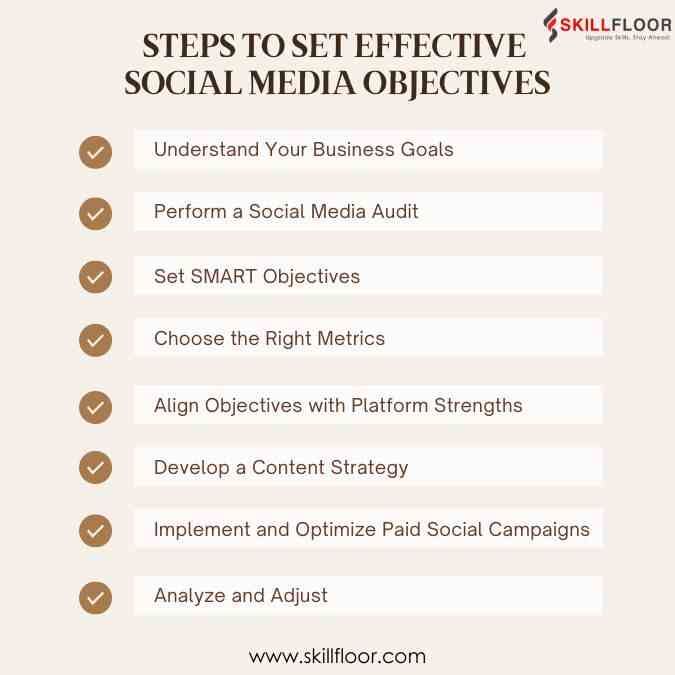How to Set Social Media Objectives for Business Growth
Learn how to set effective social media objectives to drive business growth, enhance engagement, and boost ROI with our step-by-step guide.

Setting clear social media objectives is key to growing your business through digital marketing. Think of these objectives as your guide for what you want to achieve on platforms like Facebook, Instagram, and LinkedIn. Whether you aim to raise brand awareness, generate leads, or increase sales, having specific goals helps you focus your efforts. Start by identifying what you want from your social media presence and how it aligns with your business goals. This alignment ensures that every post, comment, and interaction supports your broader strategy.
After defining your goals, it's time to create actionable social media objectives. This means setting clear targets, such as boosting website traffic by a certain percentage or growing your follower count within a set period. Use tools like Google Analytics and insights from social platforms to track your progress. Regularly check these metrics to see what’s working and where to improve. By closely monitoring your social media objectives, you can make informed decisions and adapt your strategies to stay in tune with your audience and market trends. This ongoing process helps your business thrive in the digital world.
Steps to Set Effective Social Media Objectives
1. Understand Your Business Goals
Before diving into social media objectives, it's crucial to have a clear understanding of your broader business goals. Are you aiming to increase brand awareness, drive website traffic, generate leads, or boost sales? Your social media objectives should directly support these overarching goals. For instance, if your primary goal is to increase sales, your social media efforts might focus on promoting products and driving conversions. Conversely, if brand awareness is your priority, you may prioritize content that enhances your brand's visibility and reputation.
2. Perform a Social Media Audit
A social media audit involves analyzing your current social media performance to identify strengths, weaknesses, and opportunities. Review your existing social media accounts, evaluate the engagement levels, and assess the performance of past content. Look at metrics such as follower growth, engagement rates, and website traffic from social channels. Additionally, benchmark your performance against competitors to understand where you stand in the market. This audit will provide a baseline for setting realistic and measurable objectives.
3. Set SMART Objectives
SMART objectives are Specific, Measurable, Achievable, relevant, and Time-bound. This framework ensures that your goals are clear and attainable within a specified timeframe. For example, instead of a vague objective like "increase social media followers," a SMART objective would be "increase Instagram followers by 20% in the next three months." Here’s how to apply the SMART criteria:
-
Specific: Clearly define what you want to achieve.
-
Measurable: Identify how you will measure success.
-
Achievable: Ensure the objective is realistic and attainable.
-
Relevant: Align the objective with your business goals.
-
Time-bound: Set a deadline for achieving the objective.
4. Choose the Right Metrics
Selecting the appropriate metrics is vital for tracking the success of your social media objectives. Different objectives require different metrics. For instance:
-
Brand Awareness: Track metrics like reach, impressions, and follower growth.
-
Engagement: Monitor likes, comments, shares, and engagement rates.
-
Traffic: Analyze website visits, click-through rates (CTR), and referral traffic.
-
Conversions: Measure conversion rates, leads generated, and sales attributed to social media.
Use tools like Google Analytics, social media analytics, and custom tracking URLs to gather and analyze these metrics.
5. Align Objectives with Platform Strengths
Each social media platform has unique strengths and caters to different audience segments. Align your objectives with the capabilities of each platform. For example:
-
Facebook: Ideal for community building and customer engagement.
-
Instagram: Excellent for visual storytelling and brand awareness.
-
LinkedIn: Best for B2B marketing and professional networking.
-
Twitter: Effective for real-time updates and customer service.
-
YouTube: Perfect for long-form video content and educational content.
Tailor your objectives to leverage the strengths of each platform where your target audience is most active.
6. Develop a Content Strategy
A robust content strategy is essential to achieving your social media objectives. Your content should be relevant, engaging, and aligned with your audience's interests. Consider the following elements:
-
Content Types: Determine the types of content (e.g., blogs, videos, infographics) that resonate with your audience.
-
Content Calendar: Plan and schedule content to ensure consistent posting.
-
Tone and Voice: Maintain a consistent brand voice across all platforms.
-
Visuals: Use high-quality images and videos to enhance engagement.
Your content strategy should support your social media objectives by providing value to your audience and encouraging interaction.
7. Implement and Optimize Paid Social Campaigns
Organic reach alone may not suffice to achieve your social media objectives. Paid social campaigns can amplify your reach and accelerate your results. Platforms like Facebook, Instagram, and LinkedIn offer robust advertising tools to target specific audiences and achieve various objectives. Here’s how to implement effective paid campaigns:
-
Define Campaign Goals: Clearly outline what you aim to achieve with your paid ads.
-
Targeting: Use detailed targeting options to reach your ideal audience.
-
Budgeting: Allocate a budget that aligns with your objectives and expected ROI.
-
Creative: Design compelling ad creatives that capture attention and drive action.
-
Optimization: Continuously monitor and optimize your campaigns based on performance data.
8. Analyze and Adjust
Regular analysis and adjustment of your social media strategies are essential for ongoing success. Use the metrics and data gathered to assess the effectiveness of your efforts. Identify what's working well and what needs improvement. Don’t hesitate to tweak your strategies and objectives based on insights from your analysis. Social media is dynamic, and staying agile allows you to adapt to changes and maintain momentum towards your business goals.

What strategies can be implemented to improve social media marketing performance?
To improve social media marketing performance, businesses can implement strategies such as targeting the right audience, using analytics to guide decisions and maintaining a consistent posting schedule. Targeting the right audience ensures that content reaches those most likely to be interested and engaged. Utilizing analytics provides insights into what works and what doesn’t, allowing for data-driven decision-making. Consistent posting keeps the audience engaged and ensures the brand remains visible and relevant.
-
Targeting the right audience ensures content reaches those likely to engage.
-
Utilizing analytics allows for data-driven decision-making.
-
Consistent posting keeps the audience engaged and the brand visible.
Setting clear, actionable social media objectives is a fundamental step in leveraging social media for business growth. By aligning these objectives with your overall business goals, understanding your audience, and continuously measuring and optimizing your efforts, you can effectively use social media to drive engagement, generate leads, and increase sales. Remember, successful social media strategies are not static; they evolve with your business and the ever-changing digital world.




























































